Dental Office Business Plan
The Tooth Fairy is Steve Extractor’s dentistry practice, offering general and cosmetic dentistry in Eugene, Oregon. By providing industry benchmark customer service and flexibility, The Tooth Fairy aims to quickly gain market share.
Steve will leverage his years of private practice experience to model his new business. With his forward-looking, customer-centric business model, he plans to rapidly grow a large and loyal patient base. Profitability is expected to be achieved by month 10, with sales reaching comfortable levels within two years.
Objectives:
– Create a start-up organization from an existing practice that exceeds customer expectations.
– Increase the number of clients by 20% annually through superior performance and word-of-mouth referrals.
– Establish a dentistry practice that can sustain itself through cash flow.
Mission:
The Tooth Fairy’s mission is to provide the finest dental care, attracting and retaining customers. By adhering to this maxim, everything else will fall into place. Our services will exceed customer expectations.
Keys to Success:
Meeting market needs and surpassing customer expectations.
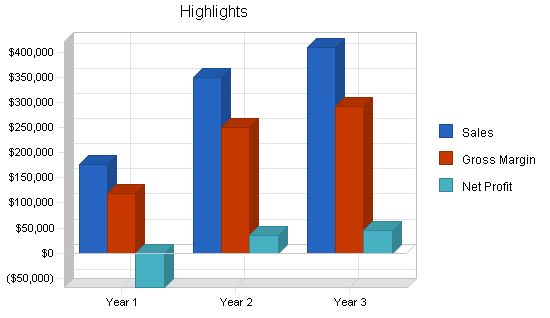
The Tooth Fairy, located in Eugene, OR, offers general dentistry and cosmetic dentistry. General dentistry includes cleaning and fillings, while cosmetic dentistry includes teeth whitening, veneers, and gap removal. The Tooth Fairy is projected to be profitable by month 10 and have respectable third year profits.
The Tooth Fairy is an Oregon limited liability corporation owned by Steve Extractor.
The required start-up costs include:
– Purchase of Dan Jokerdoc D.D.S.’ private practice. The purchase consists of the patient list, office space, front chair and desk, two dental chairs, two light systems, a fully-equipped sterilization room, a compression air system with a suction unit, an x-ray unit, mirrors, and a phone system. The practice has been valued based on equipment, built office space, goodwill, and future revenue streams. The equipment is valued at $30,000, tenant improvements at $15,000, the patient list at $5,000, and future profitability at $25,000. The total sale price for the practice is $65,000. Patient retention is likely due to comfort during the practice sale, which aids in cash flow and reduces start-up cash requirements. Some additional equipment will need to be purchased separately.
– Front desk equipment including a Xerox machine, fax machine, computer terminal with Microsoft Office, QuickBooks Pro, laser printer, and a CD-RW.
– Disposables such as assorted trays and explorers, x-ray film, filling material, paper products, and impression material.
– Placing instrument.
– Curing instrument.
– Ultrasonic scaler for prophylaxis removal.
– Sufficient high- and low-speed drills for two operators.
Note that items to be used for more than a year will be classified as long-term capital assets and will be depreciated using the straight-line method approved by GAAP.
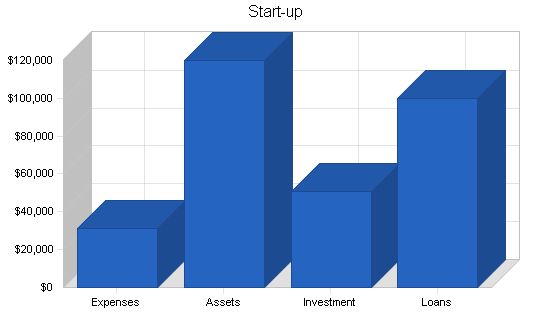
Start-up
Start-up Expenses
– Legal: $1,000
– Stationery etc.: $100
– Existing Practice (portion not a capital asset): $20,000
– Remodeling of office: $10,000
– Insurance: $0
– Rent: $0
– Research and Development: $0
– Expensed Equipment: $0
– Other: $0
– Total Start-up Expenses: $31,100
Start-up Assets
– Cash Required: $68,100
– Other Current Assets: $0
– Long-term Assets: $51,800
– Total Assets: $119,900
Total Requirements: $151,000
Start-up Funding
Start-up Expenses to Fund: $31,100
Start-up Assets to Fund: $119,900
Total Funding Required: $151,000
Assets
Non-cash Assets from Start-up: $51,800
Cash Requirements from Start-up: $68,100
Additional Cash Raised: $0
Cash Balance on Starting Date: $68,100
Total Assets: $119,900
Liabilities and Capital
Liabilities
Current Borrowing: $0
Long-term Liabilities: $100,000
Accounts Payable (Outstanding Bills): $0
Other Current Liabilities (interest-free): $0
Total Liabilities: $100,000
Capital
Planned Investment
– Steve: $51,000
– Other: $0
– Additional Investment Requirement: $0
– Total Planned Investment: $51,000
Loss at Start-up (Start-up Expenses): ($31,100)
Total Capital: $19,900
Total Capital and Liabilities: $119,900
Total Funding: $151,000
Services
The Tooth Fairy provides general improvements such as cleaning and fillings, as well as cosmetics improvements. Cleanings cost around $100, excluding x-rays. The cost of fillings varies depending on the material used. Dr. Extractor will primarily generate revenue from cosmetics by the end of the year.
Cosmetics can be classified into three areas:
– Teeth whitening: It removes stains and restores whiteness. Dr. Extractor uses a state-of-the-art home treatment. Costs are around $300.
– Veneers: Porcelain shells bonded to the front of the teeth. They reshape the tooth and make it whiter. Costs range from $600-800 per tooth.
– Gap removal: This procedure uses tooth-colored plastic bonded to places where there should be tooth material. It significantly improves the smile. The cost ranges from $300-$1,000.
The Tooth Fairy charges customers per procedure. Only a portion of the cosmetics will be billed to insurance, while the majority will be paid by the individual.
Market Analysis Summary
Dr. Extractor focuses on cosmetic improvements, targeting two customer groups:
1. Adults: Young adults, typically 27-39, concerned with appearance. This group consists of both male and female individuals with incomes over $45,000 a year. Some are professionals, while others are spouses without full-time jobs. This group considers cosmetic surgery to improve their appearance.
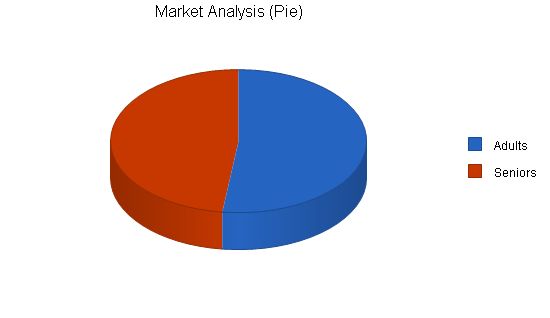
Market Analysis
| Market Analysis | |||||||
| Year 1 | Year 2 | Year 3 | Year 4 | Year 5 | |||
| Potential Customers | Growth | CAGR | |||||
| Adults | 9% | 18,774 | 20,464 | 22,306 | 24,314 | 26,502 | 9.00% |
| Seniors | 8% | 17,321 | 18,707 | 20,204 | 21,820 | 23,566 | 8.00% |
| Total | 8.52% | 36,095 | 39,171 | 42,510 | 46,134 | 50,068 | 8.52% |
Contents
4.2 Target Market Segment Strategy
The Tooth Fairy will target two segments with specific strategies in the marketing campaign. Yellow Page advertisements will develop visibility among both groups, while seminars will be specifically directed toward seniors.
4.3 Service Business Analysis
The dentist industry is shifting toward cosmetics from general maintenance. There is less decay of teeth now compared to five to 10 years ago, so dentists are focusing on areas with increased demand.
Please note that The Tooth Fairy’s growth rate is higher than the industry average. This is because Steve is concentrating on an emerging niche and starting a practice from ground zero, so higher growth rates can be expected.
4.3.1 Competition and Buying Patterns
There are two forms of competitors:
The generalist. This type of dentist has a practice centered around general maintenance and does not specialize.
The buying patterns of patients are based on referrals and trust. People prefer to choose a dentist based on a referral if possible. People new to an area may not have a referral, so they find a service provider through advertising or the Yellow Pages and form a long-term relationship if they feel comfortable with the provider.
Strategy and Implementation Summary
The marketing strategy will utilize three methods to generate visibility for The Tooth Fairy’s practice. The sales strategy will be based on educating the consumer so that their decision is informed. By educating the prospective patient, they are empowered to make a rational decision, making them feel comfortable with their choice.
5.1 Competitive Edge
The Tooth Fairy will leverage their two competitive edges to gain market share.
Customer service. The Tooth Fairy’s practice is based on a customer-centric service model. This model is emphasized when Dr. Extractor is working with patients. The Dr. believes that the patient must make an informed decision regarding their cosmetic needs. The Dr. will take time detailing what occurs during the procedure, any side effects the patient may notice, as well as the success/failure rate. Only after the patient has been educated regarding the procedure will the Dr. allow the patient to proceed with the procedure.
5.2 Marketing Strategy
The marketing strategy will develop visibility among prospective patients. The first aspect of the campaign is a large advertisement in the Yellow Pages, listing the different procedures that the Dr. offers, as well as his flexibility.
Another method to increase visibility will be free informational seminars offered by the Dr., typically through community organizations. These seminars allow people to get more information concerning cosmetics and receive a free individual consultation. The seminars will be attractive to seniors who have more free time and typically take advantage of free informational seminars.
The third marketing strategy will employ networking through the various organizations that the Dr. is a member of, including his church, the Lyons club, the Rotary club, and the country club. As a visible, active member of these organizations, the Dr. will leverage his personal relationships to generate interest in his services.
5.3 Sales Strategy
The sales strategy is based on educating the consumer so that they are asking for the service instead of the Dr. trying to convince them. This method allows the consumer to feel that they arrived at the decision themselves instead of agreeing to a sales pitch.
When a patient comes in to see the doctor, there is no charge for the initial consultation. During this consultation, the Dr. will educate the customer on the different procedures and then analyze the patient’s needs. The patient is then free to ask any questions they have. After the customer is fully knowledgeable about all the variables that will affect their procedure, they can make a decision as to whether to have any work done. This sales strategy is geared toward turning prospective customers into long-term customers who are then vocal to their friends about the pleasant experiences they had with The Tooth Fairy.
5.3.1 Sales Forecast
The first month will be used to get the new office in order, set up appointments, and begin marketing activities. Month two will see a few appointments, primarily from the prior practice. Months five through seven will see a jump in cosmetic appointments. After month seven, there should be a steady increase in sales activity.
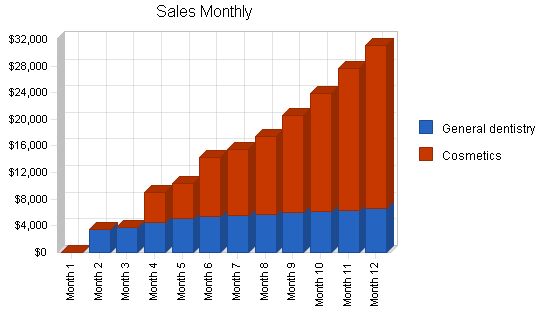
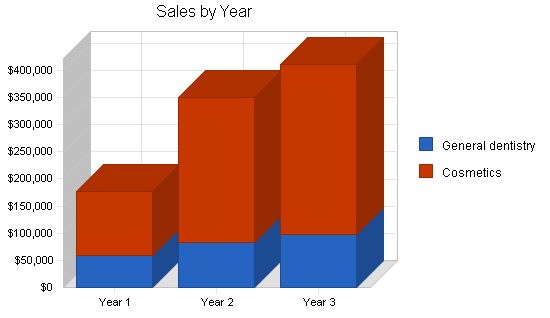
| Sales Forecast | |||
| Year 1 | Year 2 | Year 3 | |
| Sales | |||
| General dentistry | $58,551 | $82,343 | $97,656 |
| Cosmetics | $118,321 | $267,545 | $312,912 |
| Total Sales | $176,872 | $349,888 | $410,568 |
5.4 Milestones
The Tooth Fairy will have several milestones early on:
- Business plan completion.
- Office set-up.
- The 20th cosmetic procedure.
- Profitability.
| Milestones | |||||
| Start Date | End Date | Budget | Manager | Department | |
| 1/1/2001 | 2/1/2001 | $0 | Steve | Steve | |
| 1/1/2001 | 2/1/2001 | $0 | Steve | Steve | |
| 1/1/2001 | 3/1/2001 | $0 | Steve | Steve | |
| 1/1/2001 | 11/1/2001 | $0 | Steve | Everyone | |
Management Summary
Steve Extractor received his undergraduate degree in biology from Case Western Reserve. While at Case, he discovered his interest in dentistry.
Several years later, Steve graduated from The Ohio State University College of Dentistry. He immediately moved to Oregon, where he found a job in an eight-person firm practicing general dentistry.
After five years, Steve decided to learn new cosmetic techniques. He shadowed his colleagues and eventually began offering cosmetic procedures to clients.
As friction within the practice increased, Steve decided to open his own practice. He purchased an existing practice with a small patient list to save money.
6.1 Personnel Plan
In addition to Steve, a hygienist, a dental assistant, and a front desk person will be hired during month two.
| Personnel Plan | |||
| Year 1 | Year 2 | Year 3 | |
| Steve | $48,000 | $60,000 | $80,000 |
| Hygienist | $27,500 | $30,000 | $32,000 |
| Assistant | $24,200 | $26,400 | $28,000 |
| Front desk person | $22,000 | $24,000 | $26,000 |
| Total People | 4 | 4 | 4 |
| Total Payroll | $121,700 | $140,400 | $166,000 |
The following sections will outline important financial information.
7.1 Important Assumptions
The following table details important financial assumptions.
| General Assumptions | |||
| Year 1 | Year 2 | Year 3 | |
| Plan Month | 1 | 2 | 3 |
| Current Interest Rate | 10.00% | 10.00% | 10.00% |
| Long-term Interest Rate | 10.00% | 10.00% | 10.00% |
| Tax Rate | 30.00% | 30.00% | 30.00% |
| Other | 0 | 0 | 0 |
7.2 Break-even Analysis
The Break-even Analysis indicates the monthly revenue needed to reach the break-even point.
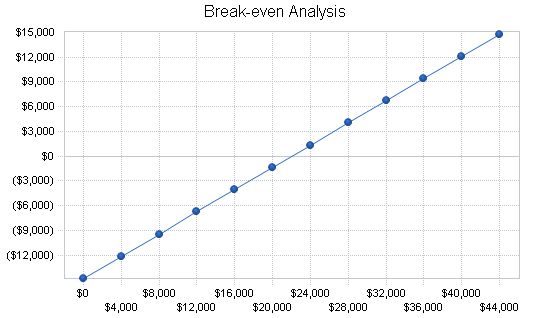
Break-even Analysis:
Monthly Revenue Break-even: $22,025.
Assumptions:
– Average Percent Variable Cost: 33%.
– Estimated Monthly Fixed Cost: $14,851.
Projected Profit and Loss:
The table below shows the projected profit and loss.
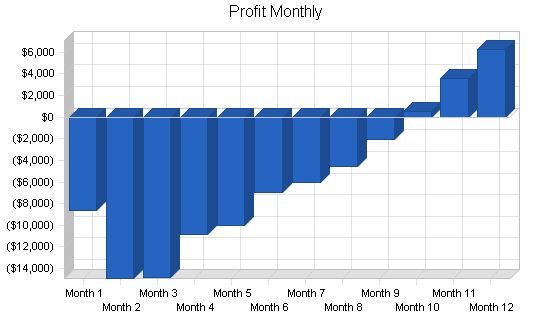
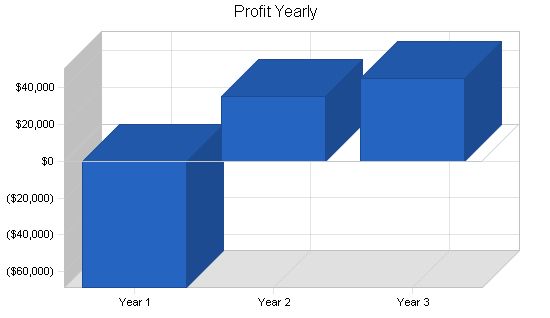
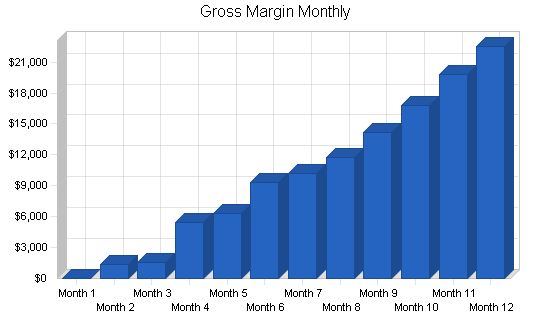
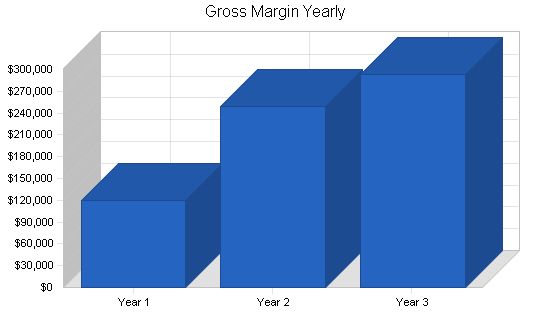
Pro Forma Profit and Loss
Year 1 Year 2 Year 3
Sales $176,872 $349,888 $410,568
Direct Cost of Sales $57,612 $100,239 $118,047
Other Production Expenses $0 $0 $0
Total Cost of Sales $57,612 $100,239 $118,047
Gross Margin $119,260 $249,649 $292,521
Gross Margin % 67.43% 71.35% 71.25%
Expenses
Payroll $121,700 $140,400 $166,000
Sales and Marketing and Other Expenses $2,700 $2,700 $2,700
Depreciation $10,356 $863 $863
ADA dues $600 $600 $600
Utilities $1,800 $1,800 $1,800
Insurance- office and malpractice $4,800 $4,800 $4,800
Rent $18,000 $18,000 $18,000
Payroll Taxes $18,255 $21,060 $24,900
Other $0 $0 $0
Total Operating Expenses $178,211 $190,223 $219,663
Profit Before Interest and Taxes ($58,951) $59,426 $72,858
EBITDA ($48,595) $60,289 $73,721
Interest Expense $9,670 $9,053 $8,362
Taxes Incurred $0 $15,112 $19,349
Net Profit ($68,621) $35,261 $45,147
Net Profit/Sales -38.80% 10.08% 11.00%
7.4 Projected Cash Flow
The following chart and table indicate projected cash flow.
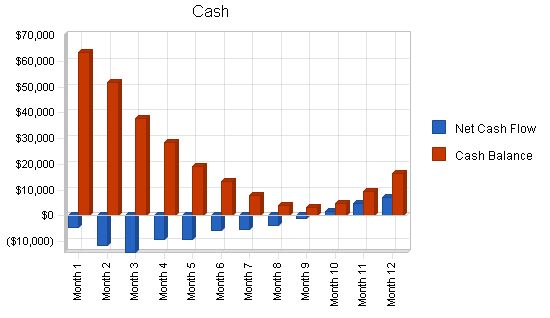
Pro Forma Cash Flow
| Pro Forma Cash Flow | |||
| Year 1 | Year 2 | Year 3 | |
| Cash Received | |||
| Cash from Operations | |||
| Cash Sales | $176,872 | $349,888 | $410,568 |
| Subtotal Cash from Operations | $176,872 | $349,888 | $410,568 |
| Additional Cash Received | |||
| Sales Tax, VAT, HST/GST Received | $0 | $0 | $0 |
| New Current Borrowing | $0 | $0 | $0 |
| New Other Liabilities (interest-free) | $0 | $0 | $0 |
| New Long-term Liabilities | $0 | $0 | $0 |
| Sales of Other Current Assets | $0 | $0 | $0 |
| Sales of Long-term Assets | $0 | $0 | $0 |
| New Investment Received | $0 | $0 | $0 |
| Subtotal Cash Received | $176,872 | $349,888 | $410,568 |
| Expenditures | Year 1 | Year 2 | Year 3 |
| Expenditures from Operations | |||
| Cash Spending | $121,700 | $140,400 | $166,000 |
| Bill Payments | $100,579 | $171,973 | $196,487 |
| Subtotal Spent on Operations | $222,279 | $312,373 | $362,487 |
| Additional Cash Spent | |||
| Sales Tax, VAT, HST/GST Paid Out | $0 | $0 | $0 |
| Principal Repayment of Current Borrowing | $0 | $0 | $0 |
| Other Liabilities Principal Repayment | $0 | $0 | $0 |
| Long-term Liabilities Principal Repayment | $6,185 | $6,576 | $7,232 |
| Purchase Other Current Assets | $0 | $0 | $0 |
| Purchase Long-term Assets | $0 | $0 | $0 |
| Dividends | $0 | $0 | $0 |
| Subtotal Cash Spent | $228,464 | $318,949 | $369,719 |
| Net Cash Flow | ($51,592) | $30,939 | $40,849 |
| Cash Balance | $16,508 | $47,447 | $88,296 |
Projected Balance Sheet
Projected Balance Sheet
The following table indicates the projected balance sheet.
| Pro Forma Balance Sheet | |||
| Year 1 | Year 2 | Year 3 | |
| Assets | |||
| Current Assets | |||
| Cash | $16,508 | $47,447 | $88,296 |
| Other Current Assets | $0 | $0 | $0 |
| Total Current Assets | $16,508 | $47,447 | $88,296 |
| Long-term Assets | |||
| Long-term Assets | $51,800 | $51,800 | $51,800 |
| Accumulated Depreciation | $10,356 | $11,219 | $12,082 |
| Total Long-term Assets | $41,444 | $40,581 | $39,718 |
| Total Assets | $57,952 | $88,028 | $128,014 |
| Liabilities and Capital | Year 1 | Year 2 | Year 3 |
| Current Liabilities | |||
| Accounts Payable | $12,858 | $14,249 | $16,320 |
| Current Borrowing | $0 | $0 | $0 |
| Other Current Liabilities | $0 | $0 | $0 |
| Subtotal Current Liabilities | $12,858 | $14,249 | $16,320 |
| Long-term Liabilities | $93,815 | $87,239 | $80,007 |
| Total Liabilities | $106,672 | $101,488 | $96,327 |
| Paid-in Capital | $51,000 | $51,000 | $51,000 |
| Retained Earnings | ($31,100) | ||
| Month 1 | Month 2 | Month 3 | Month 4 | Month 5 | Month 6 | Month 7 | Month 8 | Month 9 | Month 10 | Month 11 | Month 12 |
| $0 | $3,500 | $3,800 | $8,954 | $10,374 | $14,210 | $15,441 | $17,391 | $20,546 | $23,880 | $27,688 | $31,088 |
| $0 | $3,500 | $3,800 | $8,954 | $10,374 | $14,210 | $15,441 | $17,391 | $20,546 | $23,880 | $27,688 | $31,088 |
| $0 | $3,500 | $3,800 | $8,954 | $10,374 | $14,210 | $15,441 | $17,391 | $20,546 | $23,880 | $27,688 | $31,088 |
Pro Forma Balance Sheet
| Month 1 | Month 2 | Month 3 | Month 4 | Month 5 | Month 6 | Month 7 | Month 8 | Month 9 | Month 10 | Month 11 | Month 12 | ||
| Starting Balances | |||||||||||||
| Cash | $68,100 | $63,483 | $51,929 | $37,667 | $28,344 | $19,217 | $13,365 | $7,953 | $4,160 | $3,107 | $4,643 | $9,261 | $16,508 |
| Other Current Assets | $0 | $0 | $0 | $0 | $0 | $0 | $0 | $0 | $0 | $0 | $0 | $0 | |
| Total Current Assets | $68,100 | $63,483 | $51,929 | $37,667 | $28,344 | $19,217 | $13,365 | $7,953 | $4,160 | $3,107 | $4,643 | $9,261 | $16,508 |
| Total Long-term Assets | $51,800 | $50,937 | $50,074 | $49,211 | $48,348 | $47,485 | $46,622 | $45,759 | $44,896 | $44,033 | $43,170 | $42,307 | $41,444 |
| Total Assets | $119,900 | $114,420 | $102,003 | $86,878 | $76,692 | $66,702 | $59,987 | $53,712 | $49,056 | $47,140 | $47,813 | $51,568 | $57,952 |
| Current Liabilities | $0 | $3,629 | $6,627 | $6,797 | $7,998 | $8,528 | $9,304 | $9,618 | $10,003 | $10,720 | $11,416 | $12,158 | $12,858 |
| Current Borrowing | $0 | $0 | $0 | $0 | $0 | $0 | $0 | $0 | $0 | $0 | $0 | $0 | |
| Other Current Liabilities | $0 | $0 | $0 | $0 | $0 | $0 | $0 | $0 | $0 | $0 | $0 | $0 | |
| Total Current Liabilities | $0 | $3,629 | $6,627 | $6,797 | $7,998 | $8,528 | $9,304 | $9,618 | $10,003 | $10,720 | $11,416 | $12,158 | $12,858 |
| Total Long-term Liabilities | $100,000 | $99,508 | $99,011 | $98,511 | $98,006 | $97,497 | $96,984 | $96,467 | $95,945 | $95,419 | $94,889 | $94,354 | $93,815 |
| Total Liabilities | $100,000 | $103,137 | $105,638 | $105,307 | $106,005 | $106,025 | $106,289 | $106,085 | $105,949 | $106,139 | $106,305 | $106,512 | $106,672 |
| Paid-in Capital | $51,000 | $51,000 | $51,000 | $51,000 | $51,000 | $51,000 | $51,000 | $51,000 | $51,000 | $51,000 | $51,000 | $51,000 | $51,000 |
| Retained Earnings | ($31,100) | ($31,100) | ($31,100) | ($31,100) | ($31,100) | ($31,100) | ($31,100) | ($31,100) | ($31,100) | ($31,100) | ($31,100) | ($31,100) | ($31,100) |
| Earnings | $0 | ($8,617) | ($23,535) | ($38,329) | ($49,212)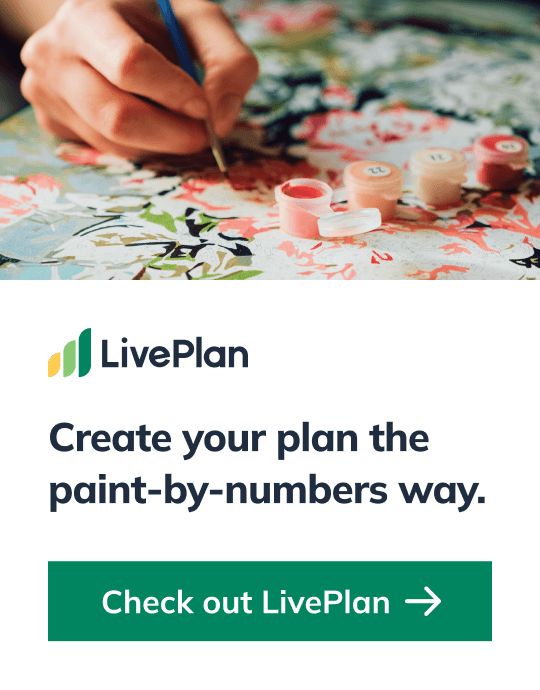
Business Plan Outline
|
Hello!
I’m Andrew Brooks, a seasoned finance consultant from the USA and the mind behind phonenumber247.com.
My career is built on a foundation of helping individuals and businesses thrive financially in an ever-changing economic landscape. At phonenumber247.com, my aim is to demystify the complex world of finance, providing clear, actionable advice that can help you navigate your financial journey with confidence. Whether it’s personal finance management, investment strategies, or understanding the nuances of market dynamics, I’m here to share insights and tools that can propel you towards your financial goals.
Welcome to my digital space, where every piece of advice is a step closer to financial clarity and success!
